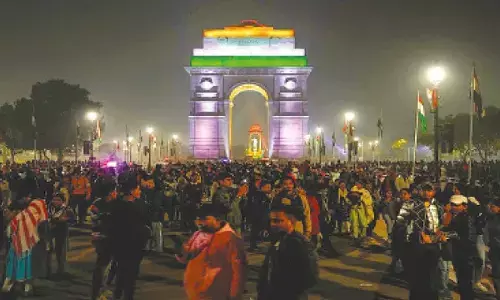Tonsuring depositors

The controversial Financial Resolution and Deposit Insurance bill (FRDI) is likely to come up in this budget session. The FRDI bill was introduced in Lok Sabha in August last. The unprecedented uproar in social media forced the government to delay its passage.
The controversial Financial Resolution and Deposit Insurance bill (FRDI) is likely to come up in this budget session. The FRDI bill was introduced in Lok Sabha in August last. The unprecedented uproar in social media forced the government to delay its passage.
Objectives of the Bill
The main objective of the bill is to put in place a framework for resolution of failures of financial institutions. The bill encompasses the entire spectrum of the financial system. The bill calls for establishment of Resolution Corporation (RC). The RC will have far-reaching powers on any financial institution which it feels moving towards a failure.
All the financial institutions like commercial banks, cooperative banks, Regional Rural banks, insurance firms, payment banks, non-banking financial companies (NBFC), mutual funds, pension funds, securities firms etc., will come under the purview of the bill for the establishment of RC to deal with such institutions where failure is a probability.
The RC will classify all financial service providers into five categories of risks to viability – low, moderate, material, imminent and critical. The financial services provider that falls in material to critical categories will come under the scrutiny of the RC. The resolution process ranges from merger with other institutions to liquidation. The RC will also use new resolution mechanisms like the controversial bail-in provisions.
Irrational measures
Does India need such all-powerful resolution regime for its financial system? The nationalisation of banks was in fact a move to deal with frequent bank failures. But, this resolution regime is aimed at reversing the process of nationalisation. India has never experienced the failure of a single public sector bank (PSB) since nationalisation. Few private sector banks failed subsequent to financial sector liberalisation that began in 1990s.
But, such failed private banks were merged with PSBs to protect the interests of depositors. On the contrary, the FRDI bill calls for tonsuring the depositors in the wake of bank failures, though they are not responsible for such a state of affairs.
The Indian financial system was largely insulated from the global financial crisis in 2008 that saw several financial institutions collapse in the United States and the European Union. Bank failures have become a rare phenomenon in India, especially in the recent past. But, why is government in such a hurry to bring in a far-reaching resolution mechanism.
Global factors
The government may claim that it is only implementing the decisions arrived at G-20 in which India is also a member. It is true that the proposed resolution regime was proposed by the Financial Security Broad (FSB) and endorsed by the G-20 summit.
The FSB proposals begin with the premise that global giants have emerged in the financial system and they suffer from the hazards described by it as Too Big to Fail (TBTF). India's largest bank, State Bank of India (SBI) ranks 55 among top hundred global banks. No other Indian bank figures in top 100 banks. The assets of even SBI are far less compared to the so-called global TBTF banks.
The financial crisis in the advanced countries is the result of privately owned financial system while India has a dominant presence of public owned institutions. But, the government wants to prescribe the same medicine being administered in the developed world for Indian financial system.
Why this rush?
According to FSB report on implementation released in July 2017, Japan has not implemented the bail-in provisions. Argentina, Australia, Brazil, China, Indonesia, South Korea, Mexico, Saudi Arabia, Singapore, South Africa and Turkey have only partially implemented the financial resolution reforms endorsed by G-20.
None of these countries implemented the bail-in provision. Then, why this rush for bail-in provision in India. The Government of India through this FRDI bill seeks to implement all the measures suggested by the FSB, though many of the emerging and developing economies are quite cautious in this regard.
Insuring depositors
The FRDI bill fails to mention the maximum deposit insurance amount. The Deposit Insurance and Credit Guarantee Act of 1961 insures deposits up to Rs 1 lakh. In fact, the FRDI bill repeals even this. The maximum insurance amount in the wake of a bank failure was Rs 1,500 when the act was enacted in 1961. It was raised to Rs 1 lakh by 1993.
There was no demand for further rise as banks rarely failed and even if any private bank fails, it was merged with the PSB to protect depositors. This was the implicit sovereign guarantee as the PSBs are government-owned.
If the government is really interested in protecting the interests of depositors through this FRDI bill, it would have substantially raised the insurance amount. Instead, the Section 29 of the FRDI bill states that RC will specify the total amount payable with respect to any one depositor in consultation with appropriate regulator.
The United States act provides for a maximum insurance of $2,50,000 which will be adjusted for inflation. Why does not the Government of India follow US in this regard?
The deposit insurance limit to per capita income to purchasing power parity ratio is only 0.2 while it is 5, 4, 12 in China, Brazil and Indonesia respectively, not to speak of the advanced economies.
Indians prefer bank deposits to any other form of savings. The proportion of bank deposits in gross financial savings stands today at 60 per cent. Should average Indian households be penalised for showing such a trust and confidence in the banking system?
What is Bail-In?
The FSB proposal for resolution states that the RC will have powers to recapitalise the failing bank with depositor's money even without the depositor's consent or knowledge.
The Clause 52 of the FRDI bill gives the RC the power to carry out bail-in, as a method of resolution.
The bail-in precisely means that the RC can cancel a liability, and modify or change the form of a liability, including the power to convert an instrument from one class to another, replace an instrument with another, direct a haircutting of collaterals and margins, and the issuance of equity to creditors. Any deposit over and above the insured amount will face such an action.
While the bailout is the use of public funds to recapitalise an ailing company, a bail-in refers to use of depositor's funds to save the bank from failing.
Government claims that depositors will not be at loss despite bail-in coming into operation as their deposits can be converted into equity. But, the value of such equity will fall much below the level when the bank is in critical condition.
Whose sin is this?
Such bail-in provisions are brought in to recapitalise the banks facing imminent failure due to ballooning non-performing assets (NPAs). But, whose profligacy is it anyway? The depositors are in no way responsible for the growing NPAs. The corporate defaulters account for 75 per cent of total NPAs. The government should have made these big corporates repay the loans rather than resort to tonsuring the depositors.
Hair-cut danger
Someone may generally get a doubt whether such bail-in provisions will actually be implemented. Look at the experience in Cyprus. Public deposits were cancelled to fund bank haircuts on bad loans. (In finance, a haircut is the difference between the market value of an asset used as loan collateral and the amount of the loan. The amount of the haircut reflects the lender's perceived risk of loss from the asset falling in value or being sold at extremely discounted prices, typically when the seller faces bankruptcy). The haircut for the depositors in Cyprus was around 47.5 per cent.
The lower the rate of recovery from the resolution process, the bigger will be the haircut that the banks will have to take. In India, the recovery rate is quite low indicating much higher haircut. The Crisil had projected on the basis of their study of 50 top NPA cases that 60 per cent haircut may have to be undertaken by the banks.
For instance, the creditors (PSBs) were allowed to draw only Rs 54 crore from M/s Synergies–Dooray Automotive’s total dues of Rs 900 crore. Going by this experience, the haircut can even be much higher than what was projected by the Crisil. This means, the banks through the bail-in provisions would transfer this haircut to the depositors.
Perilous move
At present multiple regulators like RBI, IRDA, PFRDA, SEBI regulate diverse financial institutions. This means, if the single omnipotent regulator fails, the entire financial system will be in danger. In fact, diverse regulators can serve the purpose of regulation much more effectively.
No immediate threat
All this does not mean Indian banks, especially the PSBs, are facing the threat of imminent failure. In fact, NPAs are no more than about 12 per cent of total bank assets warranting any serious apprehension. But, the only concern is that India's financial system should not become so precarious for its customers. Such provisions in the FRDI bill will only erode the trust and confidence of customers in the banking system leading to flight of capital away from banks. This would seriously undermine the financial intermediation that is so vital for the economy to survive and prosper.
(Writer is former Editor of Hans India and former Member of Legislative Council)















